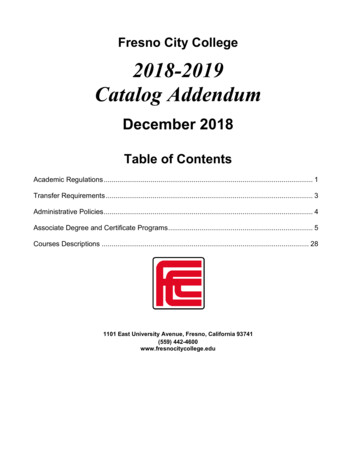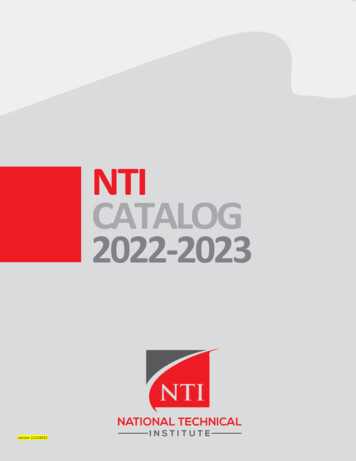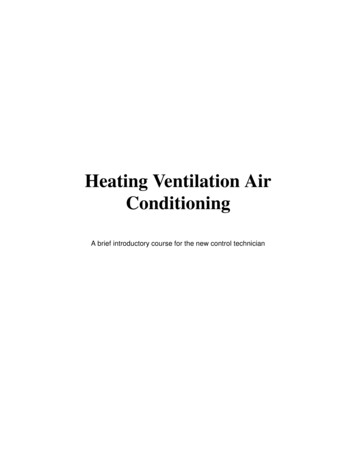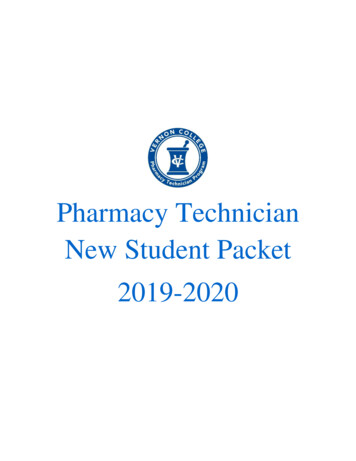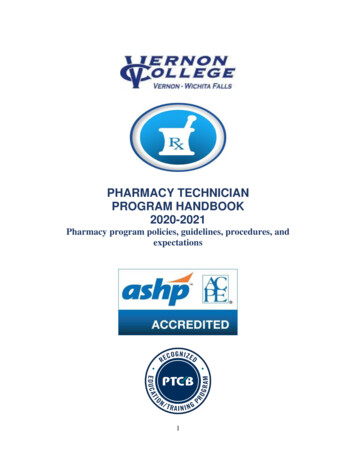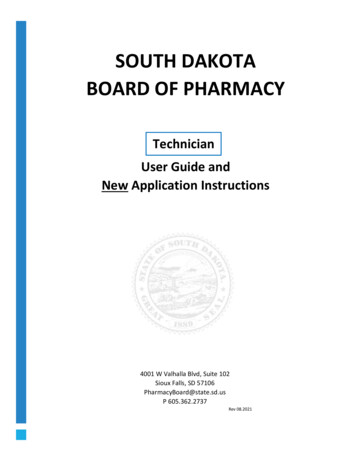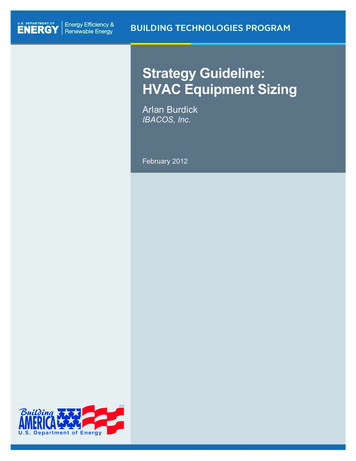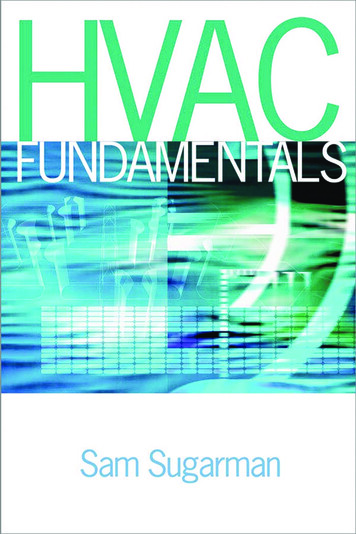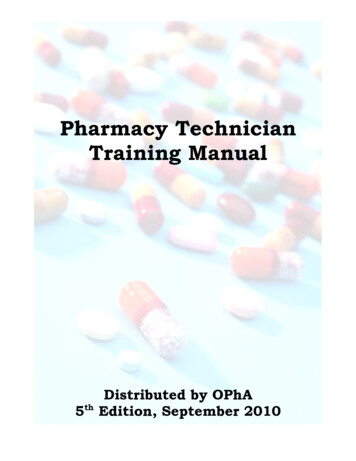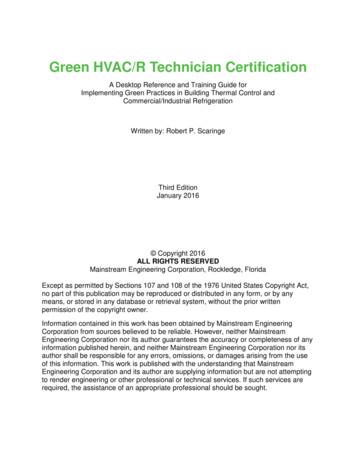
Transcription
Green HVAC/R Technician CertificationA Desktop Reference and Training Guide forImplementing Green Practices in Building Thermal Control andCommercial/Industrial RefrigerationWritten by: Robert P. ScaringeThird EditionJanuary 2016 Copyright 2016ALL RIGHTS RESERVEDMainstream Engineering Corporation, Rockledge, FloridaExcept as permitted by Sections 107 and 108 of the 1976 United States Copyright Act,no part of this publication may be reproduced or distributed in any form, or by anymeans, or stored in any database or retrieval system, without the prior writtenpermission of the copyright owner.Information contained in this work has been obtained by Mainstream EngineeringCorporation from sources believed to be reliable. However, neither MainstreamEngineering Corporation nor its author guarantees the accuracy or completeness of anyinformation published herein, and neither Mainstream Engineering Corporation nor itsauthor shall be responsible for any errors, omissions, or damages arising from the useof this information. This work is published with the understanding that MainstreamEngineering Corporation and its author are supplying information but are not attemptingto render engineering or other professional or technical services. If such services arerequired, the assistance of an appropriate professional should be sought.
Table of ContentsTable of ContentsFiguresTablesAbout Mainstream EngineeringPrefaceExamination InformationDefinitionsChapter 1: Benefits of Green HVAC/R Technician CertificationWhat is "Green HVAC/R"?Why Go "Green"?Green Certification and Green BuildingsGreen Building Certification ProgramsChapter 2: Energy Audits and Energy-Saving Equipment and SystemsEnergy AuditsEnergy-Saving EquipmentSet-Back ThermostatsVariable Air Flow Air Handlers and High Efficiency MotorsAir-to-Air Heat ExchangersRefrigerant–to-Water Heat ExchangersEconomizersHeat Pump Hot Water HeatersHeat Pump Residential Clothes DryersHigh Efficiency LightingImproved InsulationSolar FilmsSolar EnergySolar Domestic Potable Water HeatersSolar Pool HeatersCooling SystemsSteam Heating SystemsVapor Compression SystemsChapter 3: HVAC System DesignThermal Comfort ConsiderationsDesign ConsiderationsMinimum Materials SpecificationsHVAC Design MethodologyChapter 4: HVAC System Installation
General GuidelinesFabrication and Installation GuidelinesChapter 5: HVAC System ServicingRefrigerant Circuit SubsystemAir-Side SubsystemElectrical SubsystemRefrigerant Circuit Subsystem MaintenanceCheck Superheat and System ChargeCheck for AcidCheck for MoistureCheck for CorrosionChapter 6: Indoor Air Quality ConsiderationsFactors Affecting Indoor Air QualitySources of Indoor Air PollutionPollutant Pathways and Driving ForcesHVAC SystemNatural ForcesVentilation ConsiderationsDuct Work ConsiderationsPreventing Air Ducts from Getting WetTreating Air DuctsCleaning Air DuctsUnresolved Issues of Duct CleaningMold Sampling and ControlSymptoms and Complaints Typically Related to IAQ ProblemsFacility Operation and MaintenanceAir HandlerAir FiltrationMechanical FiltrationKey Points about Air CleaningChapter 7: Refrigerant HandlingOzone DepletionGreenhouse Gases and Global WarmingRefrigerant ConservationMethods to Minimize the Release of RefrigerantsKeeping Systems TightEvacuating SystemsEquipment MaintenanceBrazing TechniquesBrazing SafetyChapter 8: Hazardous Chemical HandlingChapter 9: Financial and Environmental Incentives for Green SystemsEconomic Reasons
Health Effects of Global WarmingHealth Effects of Ozone DepletionChapter 10: Introduction to Green MarketingExamples of Green MarketingAdvertising Green ServicesAdditional Green Educational Websites and Sources
FiguresFigure 1. Percentage improvement in EER with QwikSEER control board (using 14SEER Straight Cool and 14 SEER combined AC–furnace, return air: 80 F, 51%RH) 34Figure 2. Increase in humidity removal (using 14 SEER combined AC–furnace, returnair: 80 F, 51% RH) 34Figure 3. Flat-plate collectors for residential water heating and hydronic (hot water)space-heating installations 51Figure 4. Unglazed solar collectors typically used for swimming pool heating 51Figure 5. Air flat-plate collectors used for space heating 52Figure 6. Evacuated-tube collectors are more efficient at high temperatures 53Figure 7. Improvements to Filter Efficiency (Based on independent laboratory test datausing the ASHRAE 52.2 test procedure) 99
TablesTable 1. Common Light Source CharacteristicsTable 2. Variations in Fluorescent Lamp and Fixture ChoicesTable 3. Common Lighting Requirements1
About Mainstream EngineeringTable of ContentsMainstream Engineering Corporation is a solutions-oriented research, development,and manufacturing small business founded in 1986. Mainstream’s engineering missionis to research and develop emerging technologies and to engineer these technologiesinto superior-quality military and private-sector products that provide a technologicaladvantage. Areas of expertise include thermal control, energy conversion,turbomachinery, chemical-based technologies, and nanotechnology. This advancedtechnology is incorporated into all our QwikProducts (www.qwik.com) which are usedto air conditioning and refrigeration service and repair.Mainstream offers a wide range and very popular series of training and certificationprograms. You are among the hundreds of thousands of technicians who have decidedto take their professional development into their own hands by reading one of ourmanuals. After you have finished reading, we encourage you to continue your learningand development through applied experience and additional online education.We appreciate your comments and thank you for choosing Mainstream's onlinecertification services. Send comments to info@qwik.com
PrefaceTable of ContentsThe information in this course is intended for educational purposes only. Proceduresdescribed are for use only by qualified air conditioning and refrigeration servicetechnicians who are already well versed in HVAC/R service techniques and who holdvalid EPA Section 608 Certification, Mainstream Indoor Air Quality (IAQ) Certificationand Mainstream Preventive Maintenance Technician (PM Tech) certifications.This training course is not a substitute for the required EPA Section 608certification or for any equipment manufacturer’s Operator Manual. Take safetyprecautions when using all equipment. Improper use of any tool or piece of equipmentcan cause serious personal injury. Always use extreme caution when working withrefrigerants. Always wear safety glasses. Never turn on any equipment if you do notunderstand its operation. Where procedures described in this manual differ fromthose of a specific equipment manufacturer, the equipment manufacturer’sinstructions should be followed.Mainstream Engineering Corporation assumes no liability for the use of informationpresented in this publication. This information is presented for educational purposesonly. Manufacturers’ Operator Manuals must be consulted for the proper operation ofany piece of equipment.The content of this course is limited to information and service practices needed toeffectively reduce greenhouse gas emissions, reduce the escape of ozone depletingsubstances, and extend the operating life of vapor-compression equipment, typicallyutilized in the HVAC/R industry.This manual is not intended to teach fundamental air conditioning or refrigerationsystem techniques or safety practices. Likewise, this manual is not intended to teachsafe refrigerant recovery or refrigerant handling techniques. This manual assumes thetechnician is well versed with these issues and possesses an EPA-Approved Section608 certification.
Examination InformationTable of ContentsThe Green HVAC/R Technician certification exams consist of 25 questions.Technicians can take the Green HVAC/R Technician certification exam as many timesas necessary (passing grade is 21 correct out of the 25 questions, or 84%). The trainingand exam cover Green HVAC/R Technician practices for installing, servicing, repairing,and maintaining air conditioning, refrigeration, and heat pump systems.The exams are open-book and technicians have a maximum of 3 hours to complete theexam. If you retake the exam, you will automatically be given a different set of questionsfrom the test bank.Upon successfully passing the Green Certification exam, you will be issued a walletsized certification card. Diplomas, patches and truck decals are available on thewebsite for purchase.Mainstream reserves the right to revoke the Green HVAC/R Technician certificationgiven to any individual, at any time, and without prior notice, for excessive customercomplaints, unethical or illegal service practices, failure to meet Mainstream’sprofessional requirements, or any other reason deemed justifiable by Mainstreamemployees. Mainstream is under no legal obligation to disclose the reason for thetermination.
DefinitionsTable of ContentsAllergenSubstance (such as dust mites, mold or moldspores) that can cause an allergic reaction.American Society of HeatingRefrigeration and AirConditioning Engineers(ASHRAE)An international organization, founded in 1894, toadvance technology in heating, ventilation, airconditioning and refrigeration through research,standards writing, publishing, and continuingeducation.Annual Fuel UtilizationEfficiency (AFUE)A rating of how efficiently a device consumes fuelover an entire season of use. Minimum allowableAFUE rating for various systems are:Fossil fueled forced air furnaces: 78%Fossil fueled boilers: 80%Fossil fueled steam boilers: 75%APR(Air purifying respirator)A device designed to protect the wearer frominhaling harmful dusts, fumes, vapors, and/or gases.Forces contaminated air through a filtering element.ASTM (American Society forTesting and Materials)An international standards organization for materials,products, systems, and services. Provides standardsfor various aspects of the HVAC industry.BiocideSubstance or chemical that kills organisms such asmolds.Building InformationModeling (BIM)A digital computer model of the physical andfunctional characteristics of a facility. Includes LoadCalculation and Building Simulation Program. Modelcan be created prior to construction to predict theeffects of energy conservation measures (ECM).Building OccupantsDescribes people who spend extended time periodsin the building. Clients and visitors are alsooccupants; they may have different tolerances andexpectations from those who spend their entireworkdays in the building, and they are likely to bemore sensitive to odors.
Building Related Illness(BRI)Refers to illness brought on by exposure to thebuilding air, where symptoms of diagnosableillnesses are identified (e.g., certain allergies orinfections) and can be directly attributed toenvironmental agents in the air. Legionnaire’sdisease and hypersensitivity pneumonitis areexamples of BRI that can have serious, even lifethreatening, consequences.Building SimulationProgramPart of BIM analysis. Uses information from LoadCalculation Program, along with TypicalMeteorological Year (TMY) weather data, and utilityand equipment data, to compute annual energyusage and utility cost of operation.Chimney EffectSee Stack EffectCoefficient of Performance(COP)A performance rating for any type of heat pump orair conditioner. Defined as the desired effect-namely,cooling or heating capacity-divided by the powerconsumed to provide that effect, where the desiredeffect and power consumed are in like units. COPc,the Coefficient of Performance in cooling, is thecooling capacity (in Btu/hr, for example) divided bythe electrical power consumed, in the same units(Btu/hr in this example). Likewise, COPh, theCoefficient of Performance in heating, is the heatingcapacity divided by the electrical power consumed,expressed in like units. Note that COP is similar toEnergy Efficiency Rating (EER), except that EERuses mixed units; that is, the cooling or heatingcapacity is in Btu/hr and the power consumed is inWatts. This is not a good idea, but it represents asimplification of the COP concept for non-technicalindividuals. See EER.Note that COP typically decreases with temperaturelift, and that an electric (resistance) heater will havea (constant) COPh of one, which means that oneunit of electrical energy will produce one unit of heator work.Also note that COPh is theoretically one unit higherthan COPc for the same lift; that is, COPh COPc 1 for the same lift.Cooling Load CalculationThe amount of sensible heat and latent heat gainadded to the structure, including the solar heat gain
through the windows and infiltration through doors,windows, and leaks. Used to determine the size ofthe cooling system required.Dew PointIf the air is gradually cooled while maintaining themoisture content constant, the relative humidity willrise until it reaches 100%. This temperature, atwhich the moisture content in the air will saturate theair, is called the dew point. If the air is cooled further,some of the moisture will condense and form dew orcondensate liquid.Dry-Bulb TemperatureThe temperature of the air measured with a drythermocouple or thermometer with a dry bulb. TheDry-Bulb and Wet-Bulb temperatures can be usedtogether to determine relative humidity.Energy ConservationAn effort to reduce the amount of energy needed tooperate a device or process or even eliminate it.Methods include building maintenance, equipmentreplacement, addition of digital controls, and energyrecovery.ECM(Energy ConservationMeasures)Recommendations resulting from an energy audit.Can include measures to improve the efficiency oflighting, HVAC equipment, utilities, and the buildingitself.Energy EfficiencyCalculated by dividing the work produced by theenergy used within a process. The less energyconsumed to produce the work, the greater theenergy efficiency.Energy Efficiency Ratio(EER)Similar to COP, EER is a measure of the relativeperformance of a heating or cooling appliance.Defined as the desired effect-namely, cooling orheating capacity-in Btu/hr, divided by powerconsumed, in Watts, to provide that effect. Note thatthe desired effect and power consumed are inspecific and different units. EERc, the EnergyEfficiency Ratio in cooling, is the cooling capacity, inBtu/hr, divided by the electrical power consumed, inWatts. Likewise, EERh, the Energy Efficiency Ratioin heating, is the heating capacity, in Btu/hr, dividedby the electrical power consumed, in Watts.While calculating a performance rating in mixed unitsis not proper engineering methodology, thissimplification of the COP concept has been
developed for non-technical individuals. The authorbelieves this is very bad idea; however, it hasbecome an industry standard, probably because itprovides a larger number. The EER will always belarger than the COP for a system, because of thedifference in unit conversion, and can give theappearance of better performance. For example, anelectric (resistance) heater will have a COPh of 1.0and an EERh of 3.41.To convert an EER to COP, simply multiply the EERvalue by 0.293 to obtain the equivalent COP value.Energy ManagementA general term to cover the whole field of energyand its use. Can be divided into energyconsumption, demand, efficiency, and conservation.EnthalpyTotal energy contentEPA (EnvironmentalProtection Agency)Founded in 1970, the U.S. EPA leads the nation'senvironmental science, research, education andassessment efforts. The mission of theEnvironmental Protection Agency is to protecthuman health and the environment. The HVAC/Rindustry operates under EPA standards andregulations.ExfiltrationA term used to describe uncontrolled air moving outof a building.First-hour ratingRepresents how much hot water a hot water heatercan supply in a one-hour period, when it starts with afull tank of hot water. Found on energy guide labelon the water heater.Foot-CandleThe quantity of light emitted by a candle at adistance of one foot from the candle. A light thatproduces 100 foot-candles of light means that, atone foot from the light, you will receive theequivalent of the light from 100 candles. The fartheryou move the light from what you want to illuminate,the less light intensity is available, because the lighthas spread over a greater surface area. The lightintensity or brightness at the source does notchange, but the available or measured lightdecreases as the distance increases.FungiFungi are neither animals nor plants and areclassified in a kingdom of their own. Fungi include
molds, yeasts, mushrooms, and puffballs. In thisdocument, the terms fungi and mold are usedinterchangeably. Molds reproduce by makingspores. Mold spores waft through the indoor andoutdoor air continually. When mold spores land on adamp spot indoors, they may begin growing anddigesting whatever they are growing on. Molds cangrow on virtually any organic substance, providingmoisture and oxygen are present. It is estimated thatmore than 1.5 million species of fungi exist.FungicideSubstance or chemical that kills fungiGhost loadsAlso known as lazy loads, phantom loads, orstandby loads. Small drains of electricity that canadd dollars to the electric bill.HalocarbonA halogenated hydrocarbon containing one or moreof the three halogens: fluorine, chlorine, andbromine. Hydrogen may or may not be present.Heat exchangerA device that moves heat energy from one fluid toanother while maintaining a complete fluidseparation.Heating SeasonPerformance Factor (HSPF)Like the EER, this is a mixed unit ratio. In this case,it is a ratio of estimated seasonal heating output,divided by estimated seasonal power consumptionfor an average U.S. climate. Similar to SEER, whichis for cooling, it estimates the heating seasonperformance by estimating the outdoortemperatures, and it takes into account the efficiencyof the equipment for an entire heating season. TheHSPF is more of a marketing tool than a usefulengineering metric. By using a seasonally averagedoutdoor temperature instead of the worst-casetemperature, a higher performance "number" isobtained, which looks good on marketing literature.Heat Load CalculationAn evaluation of sensible heat loss from a structureto the colder outside air as well as from infiltrationthrough doors, windows, and leaks. Used todetermine the size of the heating system required.HEPA (High-EfficiencyParticulate Air)A HEPA filter is one that can remove at least 99.97%of airborne particles 0.3 micrometers (µm) indiameter. Particles of this size are the most difficultto filter and are thus considered the most penetratingparticle size (MPPS). Particles that are larger or
smaller are actually easier to filter out of the air.HumidityThe water vapor mixed with air in the atmosphereHumidity RatioAlso known as Specific Humidity, it is the ratio of themass of water contained in a mass of dry air. Forexample, the pounds of water in a pound of dry air.HydrocarbonA compound containing only the elements hydrogenand carbon.HygroscopicSubstances that readily absorb moisture. POE oilsare hygroscopic.HypersensitivityGreat or excessive sensitivityIAQ(Indoor Air Quality)Refers to the air quality within and around buildingsand structures, especially as it relates to the healthand comfort of building occupants. The quality ofbreathable air within a building.Illuminating EngineeringSociety (IES)A professional engineering society related to lighting,which provides guidelines for amount and type oflighting needed for particular task areas.http://www.ies.orgLeak RateThe rate at which an appliance is losing refrigerant,measured between refrigerant charges or over 12months, whichever is shorter. The leak rate isexpressed in terms of the percentage of theappliance’s full charge that would be lost over a 12month period if the current rate of loss were tocontinue over that period. The rate is calculated byusing the following formula:(Refrigerant added/Total Charge) x (365 days / year/ D) x 100%where D the shorter of: # days since refrigerantlast added or 365 daysLife Cycle Cost AnalysisA cost analysis that includes the total cost ofinstalling, operating, and maintaining a device for thetotal life of the device.Low-Loss FittingAny device that is intended to establish a connectionbetween hoses, appliances, or recovery/recyclingmachines, and that is designed to closeautomatically or to be closed manually whendisconnected to minimize the release of refrigerant
from hoses, appliances, and recovery or recyclingmachines.LumenOne lumen is the quantity of light equal to one footcandle falling on one square foot of area. A light thatproduces 10 lumens will have a light intensity of 10foot-candles if it is illuminating one square foot ofarea, or one foot-candle if it is illuminating 10 squarefeet. The lumen is useful because it accounts for theamount of light intensity on a surface.Lumens per wattThe ratio of the amount of lumens (light produced)divided by the energy consumed (in Watts) toproduce the light. The larger this ratio, the moreefficient the fixture.Major MaintenanceMaintenance, service, or repair that involves removalof a vapor compression system compressor,condenser, evaporator, or auxiliary heat exchangercoil.MERV (Minimum EfficiencyReporting Value) RatingA measurement designed by ASHRAE to rate theeffectiveness of air filters. Represents the worst-caseperformance of a filter when dealing with particles inthe range of 0.3 to 10 microns. The MERV rating isfrom 1 to 16. Higher MERV ratings correspond to agreater percentage of particles captured on eachpass.MoldMolds are a group of organisms that belong to thekingdom Fungi. In this document, the terms fungiand mold are used interchangeably. There are over20,000 species of mold.mVOCMicrobial volatile organic compound, a chemicalmade by a mold that may have a moldy or mustyodorNFPA (National FireProtection Association)International nonprofit established to reduce theworldwide burden of fire and other hazards on thequality of life by providing and advocating consensuscodes and standards, research, training, andeducation.NIOSH (National Institute forOccupational Safety andHealth)Federal agency responsible for conducting researchand making recommendations for the prevention ofwork-related injury and illness, disability, and deathby gathering information, conducting scientificresearch, and translating the knowledge gained into
products and services.OSHA (Occupational Safetyand Health Administration)U.S. agency whose mission is to prevent workrelated injuries, illnesses, and deaths by issuing andenforcing rules (called standards) for workplacesafety and health.Package Terminal AirConditioner (PTAC)An air conditioning system in which all componentsare in a single cabinet (unitary).PID ControllerA proportional–integral–derivative temperaturecontroller (PID controller) is a temperature controllerthat attempts to correct the error between themeasured temperature and the desired set point. Itcorrects by using the integral, proportional, andderivative temperature differences instead of simplythe temperature difference. This calculation moreprecisely predicts the thermal response of thesystem and avoids temperature undershoot orovershoot.ReclamationTo reprocess refrigerant to at least the purityspecified in the ARI Standard 700, Specifications forFluorocarbon Refrigerants, and to verify this purityusing the analytical test procedures described in theStandard.Recovery EfficiencyThe percentage of refrigerant in an appliance that isrecovered by a recycling or recovery unit.RecoveryTo remove refrigerant in any condition from anappliance and to store it in an external containerwithout necessarily testing or processing it in anyway.RecyclingTo extract refrigerant from an appliance and to cleanrefrigerant for reuse without meeting all of therequirements for reclamation. In general, recycledrefrigerant is refrigerant that is cleaned using oilseparation and single or multiple passes throughdevices such as replaceable-core filter driers, whichreduce moisture, acidity, and particulate matter.RefrigerantThe fluid used for heat transfer in a refrigerationsystem which absorbs heat during evaporation atlow temperature and pressure, and releases heatduring condensation at a higher temperature andpressure.
Relative HumidityThe ratio of weight of water in the air relative to themaximum weight of water that can be held insaturated airRenewable EnergyA repeatable source of energy, such as ethanol, ahydrocarbon fuel that can be produced throughdistillation of plants.Seasonal Energy EfficiencyRatio (SEER) RatingLike the EER, the SEER is a mixed units ratio. In thiscase, it is a ratio of estimated seasonal coolingoutput, divided by estimated seasonal powerconsumption for an average U.S. climate. Similar toHSPF, which is for heating, it estimates the coolingseason performance by estimating the outdoortemperatures, and it takes into account the efficiencyof the equipment for an entire cooling season. TheSEER is more of a marketing tool than a usefulengineering metric. By using a seasonally averagedoutdoor temperature instead of the worst-casetemperature, a higher performance "number" isobtained, which looks good on marketing literature.The minimum SEER rating for central airconditioning systems is 13 as of Jan. 23, 2006.SensitizationRepeated or single exposure to an allergen thatresults in the exposed individual becominghypersensitive to the allergen.SMACNASheet Metal and Air Conditioning Contractors'National Association. Publishes standards andmanuals that address all facets of the sheet metaland HVAC industry, from duct construction andinstallation to indoor air quality.Solar insolationSolar radiation that has been received; the rate ofdelivery of direct solar radiation per unit of horizontalsurface.Solar Rating andCertification Corporation(SRCC)An organization that provides independentcertification of solar water and swimming poolheating collectors and systems. http://www.solarrating.org/SporeMolds reproduce by means of spores. Spores aremicroscopic; they vary in shape and size (2-100micrometers). Spores may travel in several waysthey may be passively moved (by a breeze or waterdrop), mechanically disturbed (by a person or animalpassing by), or actively discharged by the mold
(usually under moist conditions or high humidity).Stack EffectThe pressure driven flow produced by convection(the tendency of warm air to rise) also calledChimney Effect.Sustainable EnergyEnergy sources that will not be depleted in atimeframe relevant to the human race. Examples aresolar, wind, geothermal, and hydro (including waveand tidal power, as well as the more common hydropower plants that derive power from water flowingover dams on rivers).Thermal massA structure’s ability to store thermal energy.Thermosiphon systemA plumbing arrangement that enables water in aheating apparatus to circulate by means ofconvection. Hot water rising and cold waterdescending in a plumbing loop to create watercirculation.UL (UnderwritersLaboratories)A U.S. privately owned and operated independent,third-party product safety testing and certificationorganization. Develops standards and testprocedures for products, materials, components,assemblies, tools and equipment, chiefly dealingwith product safety. One of several companiesapproved for such testing by OSHA.Vapor-Compression SystemThe general term referring to all air conditioners,heat pumps, refrigerators and chillers that all operateunder the principle of compressing a vapor to highpressure so that it will condense (at a highertemperature), then dropping the pressure toevaporate the refrigerant (to provide cooling),followed by re-compressing the refrigerant tocondense and complete the cycle.Wet-Bulb TemperatureThe temperature of the air measured with a wetthermocouple or thermometer with a wet bulb. Thedry-bulb and wet-bulb temperatures can be usedtogether to determine relative humidity.
Chapter 1:Benefits of Green HVAC/R TechnicianCertificationTable of ContentsAs a certified Green HVAC/R Technician, you and your company can provide an extralevel of service to your customers. By becoming green certified, you will be able todiscuss incentives to "go green" with your customers and to provide these services.The main incentive to installing green HVAC systems for most customers is costsavings. While green HVAC systems may have higher initial costs, they have lower lifecycle costs because of greater efficiency and longer equipment life. Today’s energyefficiency rating systems (EER) quantify these savings for your customers. In somecases, your customers may be able to take advantage of utility company and taxrebates for installing green systems.These systems also have unquantified benefits such as better human health fromimproved indoor air quality and better environmental health because of pollution controland lower fuel demands.The Green HVAC/R Technician QwikProducts certification program offered byMainstream Engineering consists of training in techniques for maintaining or upgradingexisting HVAC systems to reduce pollution, improve efficiency, prolong equipment life,and improve indoor air quality. You will also learn how to design, install, and maintain amodern, high-efficiency HVAC system in accordance with the most current EPAstandards.After completing this course, you will be able to discuss with your customers incentivesfor improving the efficiency of existing systems or installing new, more efficient systems.You will be able to discuss with them information about reducing energy consumptionand costs, improving indoor air quality (IAQ), and reducing emissions of harmfulpollutants into the environment.Certification consists of methods for: Performing energy audits and selecting energy-saving equipment and systems.This is discussed in Chapter 2. Designing, installing, and servicing HVAC to achieve maximum efficiency,thereby saving energy and red
Green HVAC/R Technician certification exams consist of 25 questions. Technicians can take the Green HVAC/R Technician certification exam as many times as necessary (passing grade is 21 correct out of the 25 questions, or 84%). The training and exam cover Green HVAC/R Technician practices for installing, servicing, repairing,
